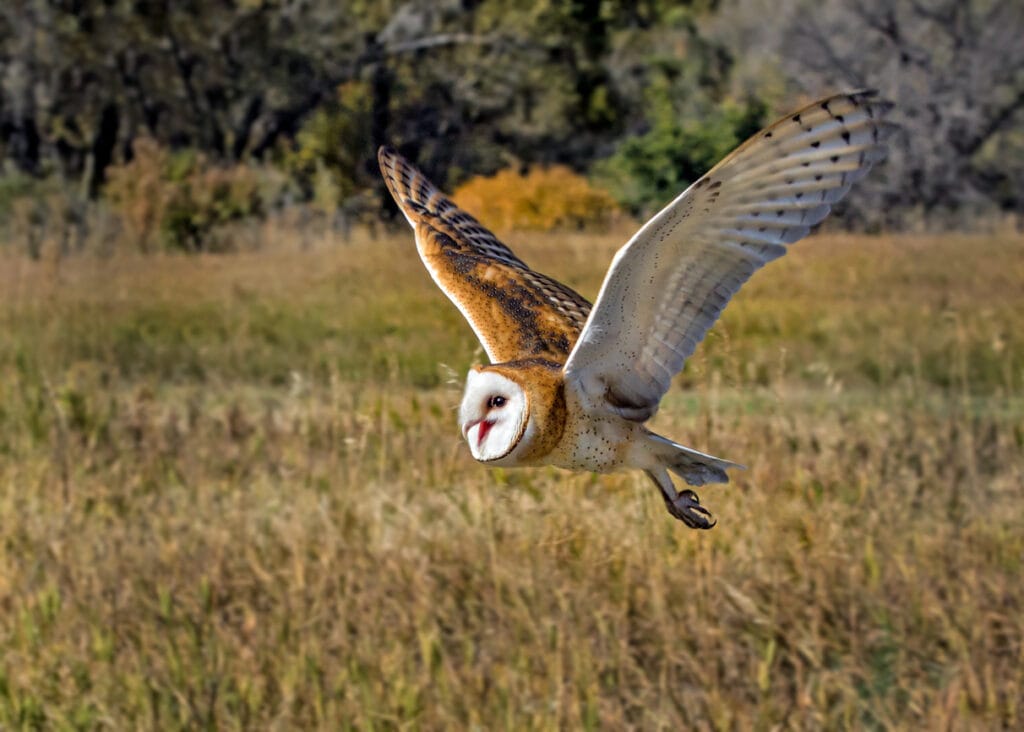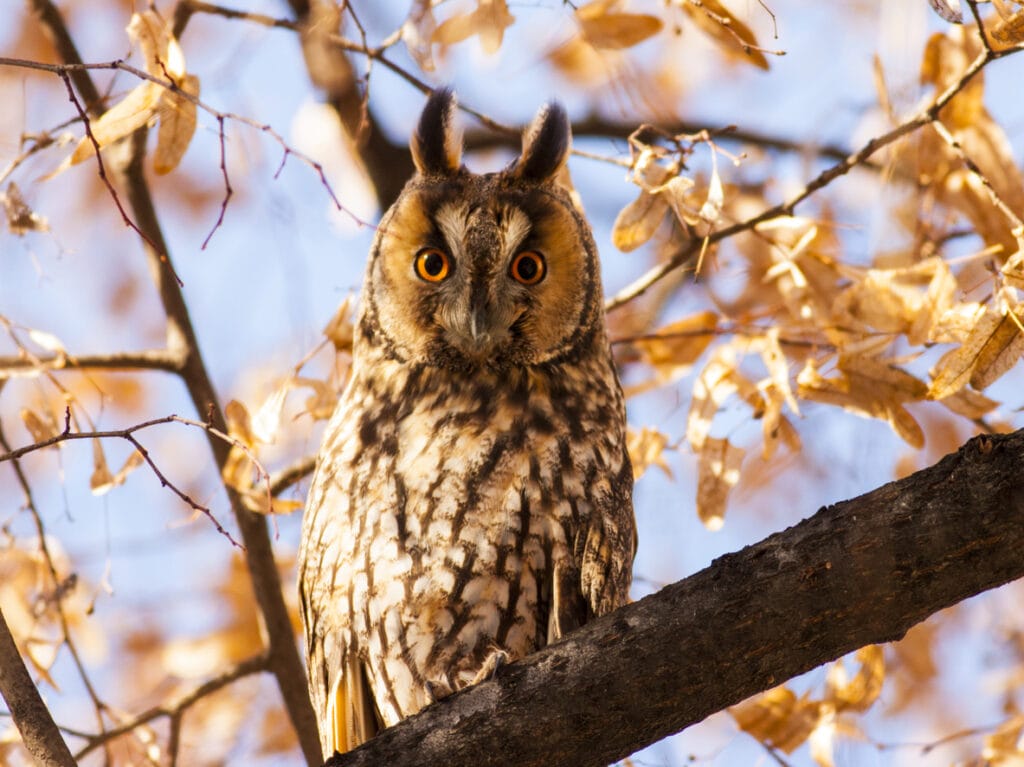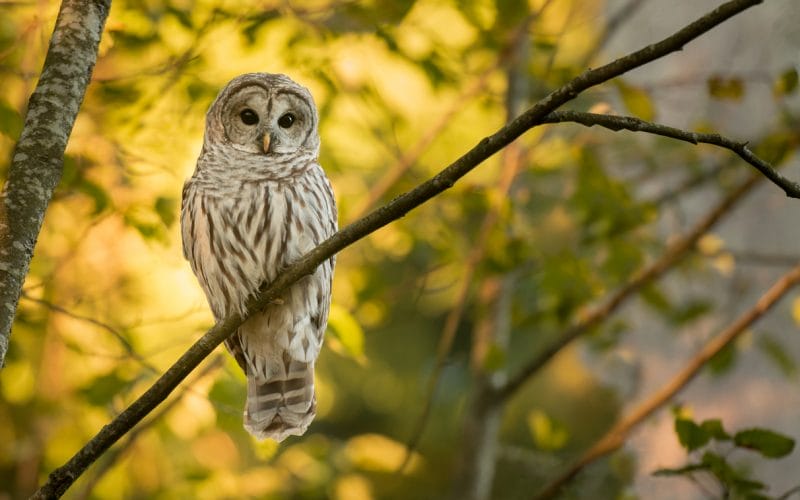Louisiana has a rich history as it’s the home to Jazz music and the delicious Creole and Cajun cuisines. But nature lovers are in for a treat because it’s also home to 485 bird species that live in the state permanently or visit occasionally.
There are many popular birding spots in Louisiana, but if you’re fond of owls, you might have to go on some birding trips at dawn or late at night.
These birds of prey usually stay concealed most of the time and suddenly ambush the prey to catch it in a split second. Keep on reading to learn more about 9 of the most popular owls in Louisiana.
9 Owls in Louisiana
Although most owls prefer to roost and nest in forested areas, some of them don’t mind nesting in nests set up by humans or abandoned buildings. The presence of forests and swamplands in Louisiana promises an abundance of prey, resulting in a greater chance of spotting different types of owls.
Here is some information about the most popular owl species in Louisiana.
1. Great Horned Owl

- Scientific name: Bubo virginianus
- Length: Between 17 and 25 inches
- Weight: Between 32 and 88 ounces
- Wingspan: Between 36 and 60 inches
Additional Information
The Great Horned Owl is an abundant and large owl in Louisiana, usually living in the state’s swamps and evergreen and deciduous forests as it’s more adaptable than most species.
Also known as the Tiger Owl, this owl has a brown and gray body and is occasionally seen near residential areas. It’s known to attack other owls, hawks, falcons, and even outdoor pets and has an intimidating look because of its ear tufts that look like horns.
Author Note: This owl has the most diverse diet among North American owls, and it usually targets prey that’s even larger than itself. It hunts at dawn and dusk but can sometimes hunt at night.
The Great Horned Owl usually occupies a nest that was abandoned by another bird species. But in some cases, it also occupies tree cavities and man-made structures. Pairs usually stay close to each other before the breeding season.
2. Flammulated Owl

- Scientific name: Psiloscops flammeolus
- Length: About 6 inches
- Weight: Between 1.8 and 2.3 ounces
- Wingspan: About 14 inches.
Additional Information
The Flammulated Owl is a small owl with fantastic camouflage. Its body is covered in a mix of brown, gray, rust, and white feathers, resembling the look of tree leaves and barks, making this owl almost impossible to detect, especially since it has a low hoot that won’t help you to locate it.
Although this owl isn’t that common to find in Louisiana, you might be able to spot one in the city parks. The Flammulated Owl usually hunts small insects, foraging for them at the top of trees.
Its favorite prey is crickets, owlet moths, bugs, grasshoppers, and beetles, and it depends on its vision to locate a flying insect and catches it on the wing.
The male Flammulated Owl uses its low hoot to mark its territory and attract the female. Then, before laying the eggs, the male will bring the female a lot of food to help her gain weight.
3. Eastern Screech-Owl

- Scientific name: Megascops asio
- Length: Between 6.3 and 9.8 inches
- Weight: Between 4.3 and 8.6 ounces
- Wingspan: Between 18 and 24 inches
Additional Information
The Eastern Screech-Owl is an all-year Louisiana resident and can be found in various wooded areas, suburban parks, and near residential areas where its favorite prey of small rodents can be easily found. The Eastern Screech-Owl also feeds on reptiles, large insects, and amphibians.
This is a stocky owl with gray and red plumage to provide the needed camouflage. Unlike other owls, which tend to be shy around humans, this one has been adapted to live near humans and won’t mind if they come really close to it.
Because it can be found in suburban areas, you might be able to attract a breeding pair to your backyard by setting up a nesting box before the breeding season, but you need to make sure that the nesting box is properly guarded to protect the nestlings from predators.
However, if you have songbirds in your backyard, they might not be that happy about the presence of the Eastern Screech-Owl, and they’ll mob it to flush it away.
4. Barred Owl

- Scientific name: Strix varia
- Length: Between 16 and 25 inches
- Weight: Between 16.6 and 37 ounces
- Wingspan: Between 38 and 49 inches
Additional Information
The Barred Owl is quite common in Baton Rouge and other cities in Louisiana, where it inhabits large and mature trees. It also prefers to nest near swamps and wetlands, which are quite common in Louisiana.
Author Note: This owl gets its name from the bars on its body, and has a mottled brownish body with white spots and black markings on the underparts. During the day, it will roost quietly in mature trees, so you’ll need to keep an eye on the tree bark to locate it.
However, its loud and unique, “ Who cooks for you?” call might help you spot it.
The Barred Owl hunts at night, attacking the prey from a perch. It feeds on small animals like mice, squirrels, voles, rabbits, and some birds. If it’s nesting near a water body, it will feed on fish and crayfish.
It stores extra food in tree cavities when prey is abundant. The owl swallows small prey as a whole but will cut a bigger one into pieces, usually swallowing the head first.
5. Short-eared Owl

- Scientific name: Asio flammeus
- Length: Between 13 and 17 inches
- Weight: Between 7.3 and 16.8 ounces
- Wingspan: Between 33 and 43 inches
Additional Information
The Short-eared Owl isn’t that rare in Louisiana and can sometimes be found near residential areas. Otherwise, it will look for nesting spots near marshes, meadows, and grass fields.
This medium-sized owl hunts by day and has a brown-buff spotted plumage with some white feathers on the underparts. It has two ear tufts, but they’re short, giving the owl its name.
The Short-eared Owl flies over short vegetation, targeting small mammals, especially mice and voles. It also feeds on rabbits, weasels, bats, squirrels, and birds. When it’s eating a mammal, the owl will decapitate it before it eats it, and it will remove the bird’s wings before swallowing it.
Although this owl hunts in daylight, it becomes active during all hours of the day during the breeding season. When the female is incubating, the male will defend the nest and bring her food.
The Short-eared Owl usually nests on the ground among low plants that conceal it from predators. The female might jump out of the nest and pretend that it’s injured to divert the attention of a predator.
6. Barn Owl

- Scientific name: Tyto alba
- Length: Between 13 and 15 inches
- Weight: Between 14.1 and 24.7 ounces
- Wingspan: Between 31 and 37 inches
Additional Information
The Barn Owl is widespread in Louisiana, especially in the southern counties near the rice and sugarcane fields, marshlands, and along the banks of the Red, Atchafalaya, and Mississippi rivers. The owl’s hoot sounds more like a scream and is a bit unsettling.
Nevertheless, despite its scary look, this is one of the most prized birds of prey to birders.
Top Tip: The owl has a buff-gray body, but it looks almost pale white in low light conditions. This is one of the most skilled nocturnal birds of prey, relying on its sensitive sense of hearing to locate its prey in pitch-black darkness.
The Barn Owl has a heart-shaped face and asymmetrical ears, so the sound waves hit both ears at different times. As a result, this owl will be able to locate the prey’s location accurately. This owl prefers to feed on rodents, especially mice. One owl can eat up to 1000 mice a year.
The male Barn Owl defends the nest aggressively and usually favors a female owl that has more spots on its body. The spots are also somehow linked to the female’s ability to resist parasites and diseases.
7. Burrowing Owl

- Scientific name: Athene cunicularia
- Length: Between 7.5 and 11 inches
- Weight: Between 4.9 and 8.5 ounces
- Wingspan: Between 20 and 24 inches
Additional Information
The Burrowing Owl’s range extends to the south of Louisiana, as it’s usually seen in the South Eastern pastures, prairies, and other open areas with sparse vegetation.
This small owl doesn’t nest in tree cavities or abandoned buildings like other owls but prefers to occupy the underground burrows excavated by the prairie dogs, squirrels, or tortoises. It can also nest in underground man-made structures that have easy access to the surface.
Both sexes of the Burrowing Owl are of the same size, and they have sandy bodies that provide the perfect camouflage in their habitat. The owl will feed on prairie dogs, mice, reptiles, insects, and small birds.
The Burrowing Owl hunts day and night, unlike other owls. It usually flies close to the ground or runs to catch the prey.
This owl has a high tolerance to carbon dioxide compared to other owls because it spends most of its time underground. Before laying the eggs, the owl will line the burrow’s entrance with animal dung to attract dung beetles.
Owls also collect rubbish like cigarette butts, aluminum foil, and pieces of trash and spread these items in front of the burrow’s entrance to announce that it’s occupied.
8. Snowy Owl

- Scientific name: Bubo scandiacus
- Length: Between 20 and 25 inches
- Weight: Between 46.4 to 88 ounces
- Wingspan: Between 46 and 65 inches
Additional Information
The Snowy Owl’s habitat extends to the far north, but it travels south in winter, and with some luck, you might be able to spot one in Louisiana, especially since snow is quite rare. But even if it happens to snow, identifying a Snowy Owl isn’t easy.
Your best chance to locate the Snowy Owl is to look at the ground. If you see a small snowball, this might be a sitting Snowy Owl.
It’s a large owl with an overall white body and some black markings on the underparts; however, male owls tend to lose their markings as they grow older. The Snowy Owl is quite noisy, producing a lot of hoots and calls to communicate with other owls. The male’s hoot can be heard up to 7 miles away.
Top Tip: The Snowy Owl uses its accurate vision and hearing to precisely locate the prey’s location, even when it’s hiding under the snow.
The male owl performs an enchanting display to attract the female during the breeding season, flying up in the air and offering her prey as it waits for approval. Unfortunately, the Snowy Owl can become quite aggressive, dive-bombing and attacking humans when it feels threatened.
9. Long-eared Owl

- Scientific name: Asio otus
- Length: Between 12 and 16 inches
- Weight: Between 7.8 and 15.3 ounces
- Wingspan: Between 34 and 40 inches
Additional Information
The Long-Eared Owl is rarely seen in Louisiana, although it inhabits the coniferous woodlands and open grasslands. It has buff and black plumage with a narrow face and long ear tufts that give the owl its name.
The Long-Eared Owl has fringed feathers that qualify it for silent flying at night. It hovers over the area until it spots the prey and then descends to catch it by surprise. During the day, the body provides the perfect camouflage while the owl is roosting, making it almost undetectable.
It’s a sociable owl, and individuals prefer to roost in big groups. It also doesn’t mind sharing the nesting areas with other birds like the American Crow.
Author Note: The owl feeds on small mammals, especially voles, mice, shrews, and kangaroo rats. The Long-Eared Owl bites the prey on the back of the head and then swallows it as a whole. After that, it coughs up the indigestible fur, bones, and hair remains in pellets.
Male owls are noisier than females, repeating their hoots every few seconds. The owls usually occupy the nests abandoned by other birds or lay their eggs in tree cavities.
Wrap Up
Owls can be found in several areas across Louisiana, and you can spot them during different hours of the day and night. Owls can be found in state parks, open areas, and near residential areas, but finding them can be challenging.
This is why you need to be patient while searching between the dense trees to find a curious pair of eyes looking at you, as this experience is totally worth it. We hope you enjoyed our guide on the most common owls in Louisiana.
FAQ
The Barred Owl is locally common in certain parts of Louisiana.
To find out where recent sightings of owls have been, try eBird. You can search for the latest sightings or particular species or what has been seen in a certain area.
Lake Martin and Catahoula National Wildlife Refuge are good places to start looking for the Barred Owl.










